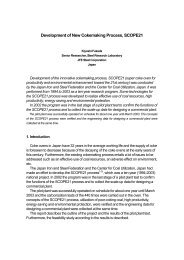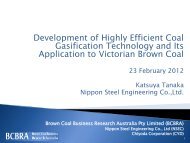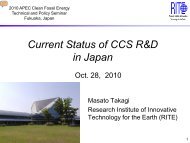Defining CCS Ready: An Approach to An International Definition
Defining CCS Ready: An Approach to An International Definition
Defining CCS Ready: An Approach to An International Definition
- No tags were found...
Create successful ePaper yourself
Turn your PDF publications into a flip-book with our unique Google optimized e-Paper software.
Chapter 2: Capture <strong>Ready</strong> Plant <strong>Definition</strong>equipment, materials, and services, the technical feasibility of the <strong>CCS</strong> retrofit can be betterdemonstrated while also minimizing delays in obtaining such equipment and services at thetime of retrofit. It can also help reduce costs, promote the sharing of knowledge, improvecommunication, speed the deployment of technologies, and assist with financial burdens.The results of a survey conducted by Global <strong>CCS</strong> Institute found that obtaining contractualagreements for <strong>CCS</strong> can be time consuming. 52 Prior preparations by indentifying sources andeven obtaining non-binding letters of intent or contingency contracts will reduce the risk ofconstruction delays upon the need for eventual <strong>CCS</strong>, and reduce the risk of plants beingplanned with capture technology but no feasible options for CO 2 transport and s<strong>to</strong>rage.The implementation and testing of large-scale <strong>CCS</strong> will involve a number of participants withexpertise in various areas and stages of technology deployment. The success of a projectwill depend on the selection of knowledgeable, innovative, reliable, and competent partners<strong>to</strong> assist with the planning and implementation. Thus, it is important <strong>to</strong> identify partners thatcan help in choosing the best methodology given a plant’s characteristics, and, once thecapture methodology is chosen, can provide the project developer with the necessaryequipment and materials such as filters, boilers, solvents, membranes and sorbents,gasification reac<strong>to</strong>rs, and water-gas-shift reac<strong>to</strong>rs. 53Global <strong>CCS</strong> Institute, US DOE/NETL, 54 and MIT 55 have prepared comprehensive lists ofCO 2 capture projects across the world, by region and capture technology, along with thecontributing partners (such as coal, electric, chemical, and engineering companies, as well asthe government). These lists provide possible vendors and partners for <strong>CCS</strong> projects. Thevendors and service providers will be different for each country, and perhaps even withindifferent regions of a country.2.4.5 Maintaining Capture ReadinessA thorough assessment of a <strong>CCS</strong> <strong>Ready</strong> plant and its eventual retrofit plan cannot bedeemed completed or sufficient by undertaking only a one-time fulfilment of all the aboveelements and their relevant requirements. Regular assessments of a plant’s Capture <strong>Ready</strong>status are important <strong>to</strong> adapt projects <strong>to</strong> foreseeable changes such as new technicaldevelopments, additional costs, and delays. Since deployment of <strong>CCS</strong> technology takes timeand effort, it is important <strong>to</strong> maintain the ability <strong>to</strong> deploy <strong>CCS</strong> as soon as possible whenmandated or when technology permits.By being Capture <strong>Ready</strong> and maintaining this status, barriers <strong>to</strong> <strong>CCS</strong> deployment furtheralong the timeframe can be removed. For example, an applicant can ensure that:52 Global <strong>CCS</strong> Institute. (2009a). Strategic analysis of the global status of carbon capture and s<strong>to</strong>rage. Report 1: Status ofcarbon capture and s<strong>to</strong>rage projects globally (Final Report). Canberra ACT, Australia: Author.53 Special filters and thermo-resistant materials and equipment, especially for full-scale industrial deployment of carboncapture technologies. Costs of capture, fixed and variable, may be reduced through the use of special membranes andsorbents, with tailored filtering properties, still at the labora<strong>to</strong>ry stage of development. With funding from the US DOE, theNETL has developed ionic liquid membranes that surpass polymers in terms of CO2 selectivity and permeability at elevatedtemperatures for pre-combustion applications. The ability <strong>to</strong> gain access <strong>to</strong> this technology implies not only a reduction incost, but also a quicker payback period through an accelerated schedule of <strong>CCS</strong> deployment.54U.S. Department of Energy, National Energy Technology Labora<strong>to</strong>ry (U.S. DOE-NETL). (2010). Carbon sequestration:NETL carbon capture and s<strong>to</strong>rage database.55 Massachusetts Institute of Technology (MIT). (2010). Carbon dioxide capture and s<strong>to</strong>rage project database.23 February 2010 33
















